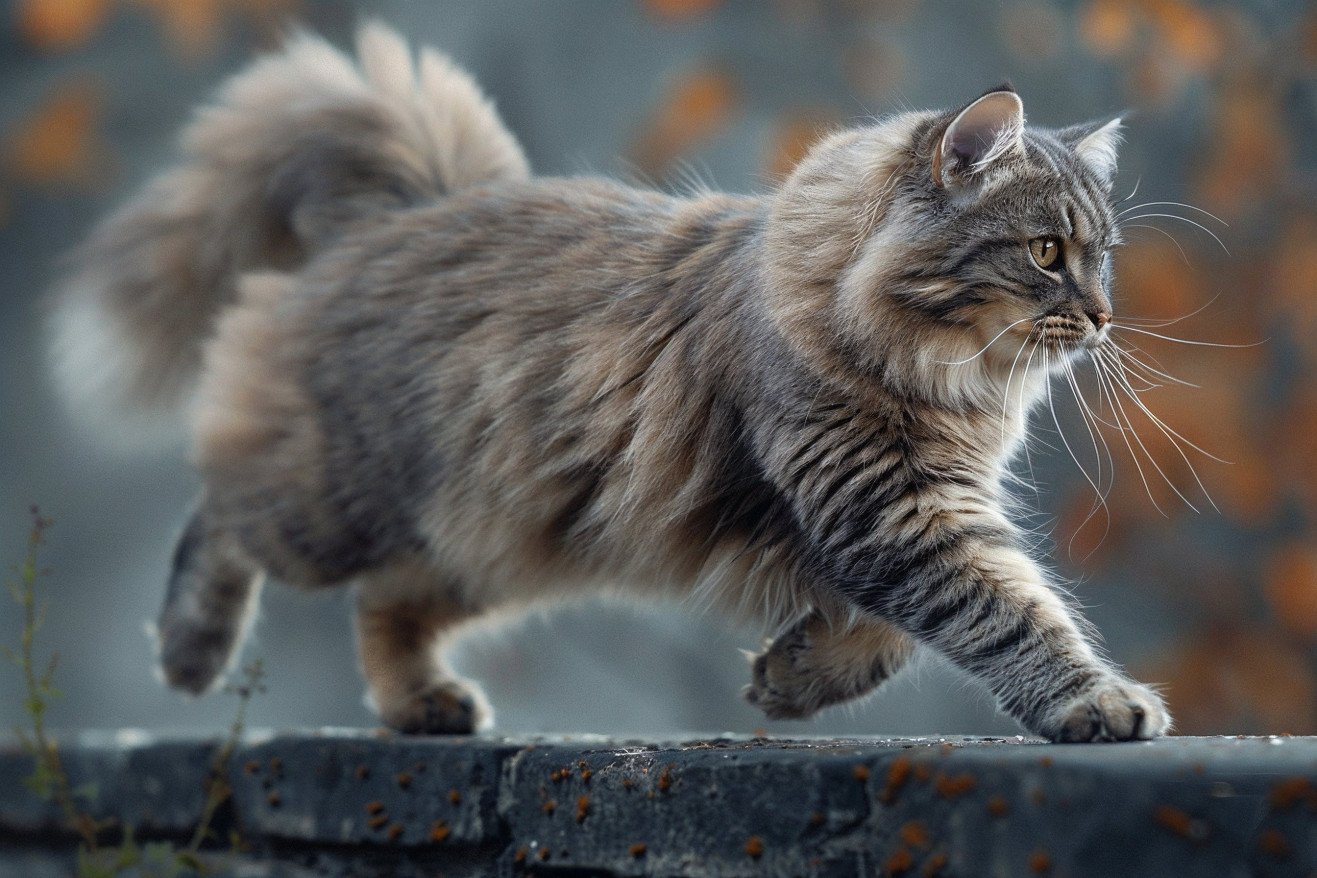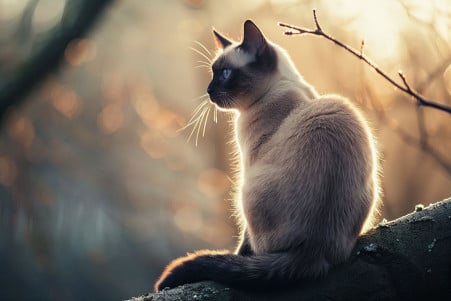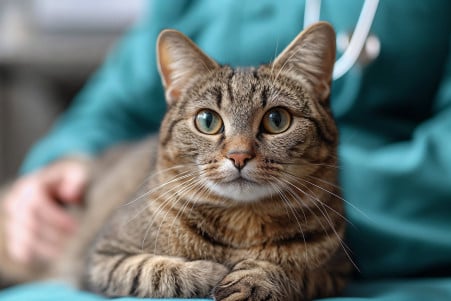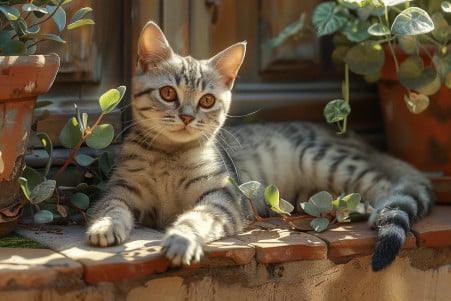Cat Tail Control: An Investigation of Feline Agility and Evolutionary Functions
31 May 2024 • Updated 30 May 2024

Cats are often celebrated for their agility and athleticism, but how much do you know about how much control they have over their tails? It turns out that cats have an impressive amount of tail control, thanks to a complex system of muscles, tendons, and nerves that enable a wide range of movements that are essential for balance, communication, and hunting.
In this article, we'll delve into findings from veterinary science, biomechanics, and ethological research to provide a comprehensive look at the biological underpinnings and evolutionary functions of cat tail control. This research has led to some interesting discoveries about cat anatomy, behavior, and the role tails play in their hunting abilities and social lives.
Can cats control their tails?
Anatomy of the Tail and Motor Nerve Control
The tail is an elongation of the spinal column, consisting of 18 to 23 caudal vertebrae that get smaller from the base to the tip. In addition to the bony vertebrae, the tail is made up of a complex network of connective tissues, including ligaments and tendons, as well as muscles, blood vessels, nerves, skin, and hair. Although the spinal cord doesn't run through the tail vertebrae, a system of nerves that extend from the spinal cord innervate the tail.
The majority of tail movements are voluntary and are controlled by motor nerves that carry signals from the brain to the muscles in the tail. However, sensory nerves also provide the cat with information about the tail's position and movement, which allows the cat to control the tail with precision by sending sensory input to the brain. The tail is moved by three sets of muscles - the dorsal muscles that lift the tail, the ventral muscles that lower the tail, and the lateral muscles that move the tail from side to side.
This complex anatomy, which combines voluntary motor control with involuntary sensory awareness, is what enables cats to use their tails to maintain balance, move nimbly, and express their emotions. Although some tail twitches may be involuntary, cats have a high degree of control over the position and movement of their tails.
Tail Movements Help With Balance and Grace
One of the most important functions of a cat's tail is to help it balance, especially when it's walking on narrow or high surfaces, according to The Dodo. Tail movements also help cats twist and turn their bodies more easily, which makes them more agile. As Spectrum Local News points out, cats use their tails to help them balance when they jump, land, and perform other acrobatic moves.
Meanwhile, cats that are born without tails, such as the Manx breed, can make up for the loss of their tails by making changes in their hind limbs and vestibular system, according to Pets Stack Exchange. In addition, real-life examples and case studies have shown how cats use their tails to help them balance and move more gracefully, which has helped researchers learn more about the cat's ability to move with agility and grace.
Tail Talk: Expressing Emotions and Intent
Cats also use their tails to express their emotions and intent to other cats and their human companions. PetMD notes that the position and movement of a cat’s tail can express a variety of feelings, including happiness, curiosity, irritation, aggression, and fear. For example, a high, raised tail is a sign of a happy, confident cat, while a low, tucked tail is a sign of anxiety or fear.
Twitching, swishing, and quivering tails can also express different levels of excitement, focus, and overstimulation. The Rover blog explains that a slow, gentle swish can indicate curiosity or relaxation, while a fast thrashing tail can indicate irritation. A quivering tail is a sign of a cat that’s overstimulated, such as when it’s greeting its favorite human.
Learning to read a cat’s tail language can help you understand their emotional state and what they may need. The Wildest explains that paying close attention to a cat’s tail position and movement can help cat parents learn to understand their pet’s feelings and react accordingly, which can help you build a closer relationship and be a better caregiver.
Tail Wagging: More Than Just Happiness
While dogs wag their tails almost exclusively when they're happy, cats wag their tails for a number of different reasons. Purina lists anger, fear, playfulness, focus, and love as some of the emotions that a cat can express through tail wagging. Lower tail flicks, slow swishes, and tails that are puffed up are all signs of negative emotions like anger or stress.
Meanwhile, fast swishes and tail quivers are signs of positive emotions or a cat's hunting instinct. The Comfort Zone notes that cats may also wag their tails more vigorously when they're playing, swishing their tails from side to side. Even the way a cat's tail twitches when they're sleeping or lying down can be a sign of pain or discomfort.
Paying attention to the details of a cat's tail wagging can help pet parents better understand their cat's emotional state and what they might need. By looking at the direction, speed, and other body language cues, pet parents can more accurately assess their cat's feelings and act accordingly.
Life Without a Tail: Consequences and Coping Mechanisms
If a cat loses its tail due to injury or medical reasons, it can adapt and live a normal life. According to GreenMatters, tail amputation (caudectomy) is often used to treat traumatic injuries or infections. Although it can initially lead to balance issues, Pets Stack Exchange says that cats can compensate by making changes in their hind limbs and vestibular system.
Cats born without tails, like the Manx breed, can also balance just fine, but PetMD explains that they are more likely to have spinal deformities and other health problems. As Purina explains, cats can adapt to losing their tails with the right care and changes to their environment. With the help of their humans, these adaptable cats can overcome the obstacles of not having a tail.
Conclusion: Understanding the Many Functions of Cat Tails
Cats do have a high degree of control over their tails thanks to a complex system of muscles, tendons, and nerves that enable precise movements for balance, communication, and hunting. As Catster points out, while the exact level of control cats have over their tails is not well understood, cats do control their tails to some extent.
It seems that the positions the tail is held in are more under the cat's control than the movements, such as flicking and wiggling. For example, a high, curved tail is a sign of a happy, alert cat, while a high, straight, bristled tail indicates fear. A low, downward-pointing tail is a sign of a negative emotional state, while a tail that's in a neutral position and relaxed is a sign of a cat that's feeling calm.
Meanwhile, the flicking or thrashing of a cat's tail can indicate a range of emotional states, from relaxation to irritation. However, as Catster points out, these movements are thought to be more reflexive than voluntary.
While some tailless cat breeds, such as the Manx, are prone to health problems related to their lack of a tail, most tailless cats can adapt and live full, active lives, according to The Tiniest Tiger. While their balance may be affected at first, they can adjust by using their hind legs and vestibular system differently.
In the end, the many functions of a cat's tail, from balance and agility to the expression of emotions, are a testament to the complexity of feline anatomy, behavior, and evolution. More study and observation can help to further unravel the mysteries of this fascinating body part.


